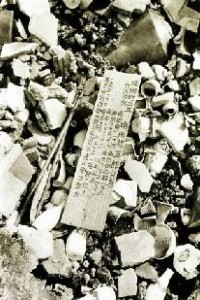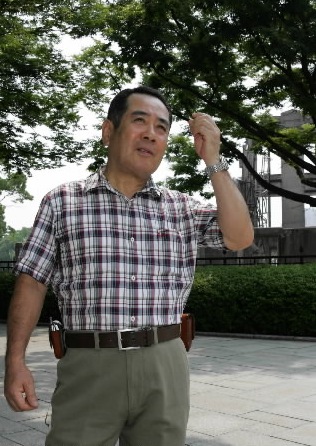Images of the Atomic Bombing, 1945~2007, Part 1
Jun. 27, 2010
Message board at the hypocenter
by Masami Nishimoto, Senior Staff Writer
What were the consequences of the atomic bombing of Hiroshima? What consequences continue to linger on? This series [originally published in August 2007] traces the people linked to photographs which record the A-bomb devastation. With some voices in Japan now contending that the nation should arm itself with nuclear weapons, it is time to stress the reality of the destruction these weapons wreak.
Evidence of lost family stirs sorrow
This photo was taken on October 1, 1945 by Shigeo Hayashi, a photographer from Tokyo who ventured into Hiroshima's hypocenter. At the time he was a member of a government team documenting the damage caused by the bombing. In 2000, two years before his death at the age of 84, he donated 232 negatives to Hiroshima Peace Memorial Museum. The address "35 Sarugaku-cho" seen on the message board corresponds to the area east of the A-bomb Dome in Peace Memorial Park. A catering shop called "Kadohatsu," with living quarters in the building, used to stand there. The life that had been present up to that morning was wiped out by the bomb when it ravaged the city.
Chuji Sumida, 64, whose name appears in the photo titled "Message Board at the Hypocenter," is still alive and well in the city of Hiroshima. After sending him a letter with this photo, I visited him. He felt some reservations about telling his story, but he spoke frankly with me.
"I was too young to remember my father's face," he said. The photo enabled him to see, for the first time, evidence of the home where he was born. He had never visited Peace Memorial Museum.
"I didn't want to remember the past," he explained. Although he has no direct recollection of the bombing, which instantly claimed the lives of many members of his family, he would probably be haunted by memories of the days afterwards.
Mr. Sumida's grandfather, Hatsugoro, was 66 at the time; his name appears at the extreme right of the message board. His father, Juichi, then 36, had taken over the family business "Kadohatsu." Denzaburo, then 30, was his uncle; Hisayo, then 58, was his grandmother; and Tomie, then 27, and Midori, then 21, were his aunts. All six were killed in the bombing.
Mr. Sumida and his mother, Fusako, who died five years ago at the age of 86, had evacuated earlier to his grandfather's house outside the city center. Fusako was pregnant and they were traveling back and forth to "Kadohatsu."
Enroute to downtown Hiroshima, they were changing trains when the bomb exploded.
Seijiro Aoyama, whose name is also on the message board, is the husband of Hatsugoro's daughter. He had evacuated to Hatsugoro's house, too. Sumiko Kimura, 64, Mr. Aoyama's oldest daughter and a resident of Takamatsu City, Shikoku, said that the names on the board were written by her father Seijiro. He was a painter and had entered Hiroshima in search of relatives. There, he learned of Hatsugoro's death.
Mr. Sumida, along with his mother and his younger brother who was born two months after the bombing, moved into "Wako-en," a home for mothers and children built near Hiroshima Castle. He lived there in a small room until he turned 18. His mother worked for an insurance company while raising her two sons. During his university days, Mr. Sumida worked to make ends meet, then took up a job at a Tokyo trading company after graduation. Although he was transferred to various locations in Japan, he never failed to visit his family grave each August 6 with his wife and children.
Mr. Sumida's wife, Mitsuko, 55, added to his account, relating something her mother-in-law had once told her: "That morning he and his mother left home later than usual because he was busy playing with toys." Mr. Sumida and Mitsuko now live alone as their two children are now grown.
Moved by the photo, Mr. Sumida said that he felt, for the first time, like visiting the site of the old family home. Even after the passing of 62 years, his heart aches with feeling.
"The atomic bomb stole everything from us, even making the survivors miserable," he said. "I can never accept the sort of comment that 'It couldn't be helped.' My mother didn't utter a single word of complaint her whole life, but I think she would agree with me." He still keeps his family register on file in the former Sarugaku-cho.
After visiting the site of his old home, Mr. Sumida and I spoke with Tsuneo Kasai, 73, the caretaker of a building near Peace Memorial Park. Mr. Kasai was born in Sarugaku-cho, and he used to play in front of "Kadohatsu."
"The son of Kadohatsu is alive!" Mr. Kasai exclaimed. "Your father was a dashing man in his high wooden clogs. You look just like him." As he listened to Mr. Kasai go on, Mr. Sumida took off his glasses and wiped away a tear.
(Originally published on August 9, 2007)









